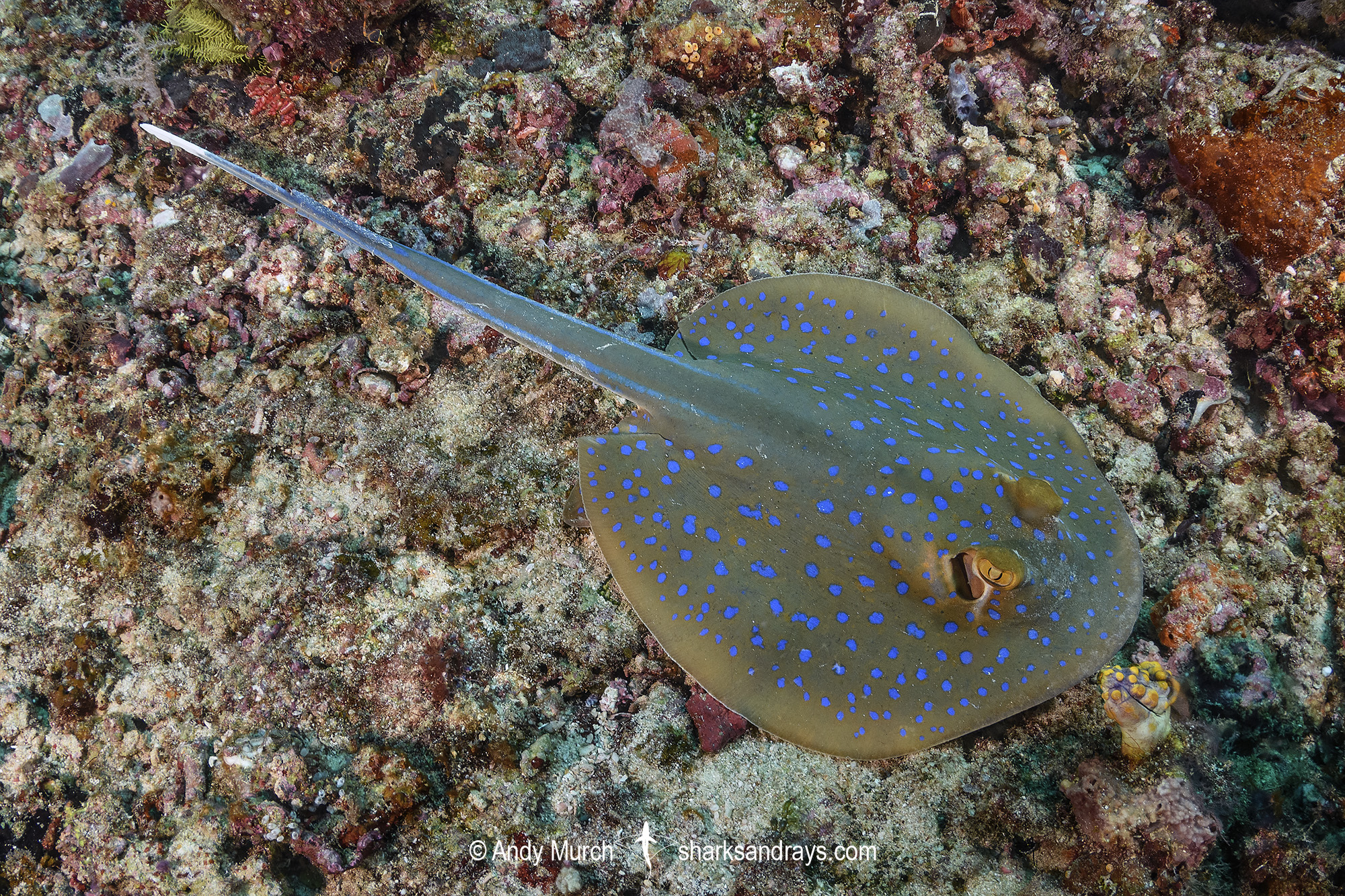Common name(s)
Bluespotted Fantail Ray, Blue Spotted Ribbontail Ray.
Identification
A small stingray with an oval disc that is longer than wide; disc width approximately 0.8 x length. Snout short and rounded. Tip of snout not extended. Anterior margins of disc convex. Pectoral fin apices broadly rounded. Pelvic fins short; apices narrowly rounded.
Eyes large and highly protruding. Snout length 2x combined eye and spiracle length. Eyes close together.
Mouth with 2 large oral papillae. Prominent labial furrows around mouth. Prominent papillae on nasal curtain and lower lip. Nasal curtain narrow and long; posterior margin V-shaped and heavily fringed. Nostrils long and thin.
Small patch of thorns on nape. A row of thorns usually extend from nape to base of tail. Tail broad and depressed at base, tapering gently to caudal sting, then fairly thin to tip. No prickly denticles on tail. Tail length (when intact) approximately 1.5 x disc width. Ventral finfold very long; stretching from before midpoint to tip. Dorsal finfold barely discernible; a fleshy ridge. Two tail stings usually present.
Colour
Dorsum orange-yellow to olive-brown with many large blue spots. Ventrum white often with a broad yellowish margin. Blue stripes run along tail to caudal sting. Tail beyond sting pale blue with a white tip. Ventral finfold pale or yellow-brown fading to blue near margin, solid white towards tip of tail.
Size
Maximum disc width 35cm. Disc width at birth 13-14cm.
Habitat
Tropical seas. On sandy substrates adjacent to reefs and in sea grass beds. Intertidal to 20m.
Distribution
Widespread in the Indo-West Pacific. South Africa and Madagascar to Australia, including the Red Sea, Arabian Gulf, India and Sri Lanka, and throughout southeast Asia and northern Australia.
Conservation Status
NEAR THREATENED
The bluespotted fantail ray is commonly taken where heavy artisanal and small-scale commercial fisheries occur in or around coral reef habitats. Additionally, it may possibly be exploited locally for capture for the marine aquarium trade. It is at risk in many areas because of its dependence on coral reef habitats. These are under massive assault from net, dynamite and cyanide fisheries for teleosts in many places where the species occurs. In East Africa, artisanal fishers catch T. lymna using bottom¬set gillnets, longlines and skin-diving with spears, and also as bycatch in fence traps (S. Yahya and N. Jiddawi pers. obs.). Habitat loss and degradation therefore likely exert a significant impact on populations.
Citation
Compagno, L.J.V. 2009. Taeniura lymma. The IUCN Red List of Threatened Species 2009: e.T39412A10229354. https://dx.doi.org/10.2305/IUCN.UK.2005.RLTS.T39412A10229354.en. Downloaded on 25 February 2021.
Reproduction
Matrotrophic viviparity. Litter size unknown.
Diet
Feeds on bivalves and other molluscs, and marine worms.
Behavior
Sedentary. Rests under reef ledges and in caves during the day. Feeds nocturnally.
Reaction to divers
Fairly easy to approach when resting. Usually retreats deeper into caves or under ledges when closely approached.
Diving logistics
Bluespotted faintail rays are not known to form aggregations, so there are no particular spots where they are especially abundant but they are regularly encountered throughout their range.
I have seen this species in too many spots to cover here. Ningaloo Reef off of Western Australia seemed to have a very good supply., as did Raja Ampat and numerous other dive destinations in Indonesia.
What’s new
View our full list of updates
Similar species
Bluespotted Maskray This and other bluespotted members of the Kuhlii-complex are easily distinguishable by their kite-shaped discs, dark patch across the eyes, and more whiplike tail with much shorter ventral finfold.





